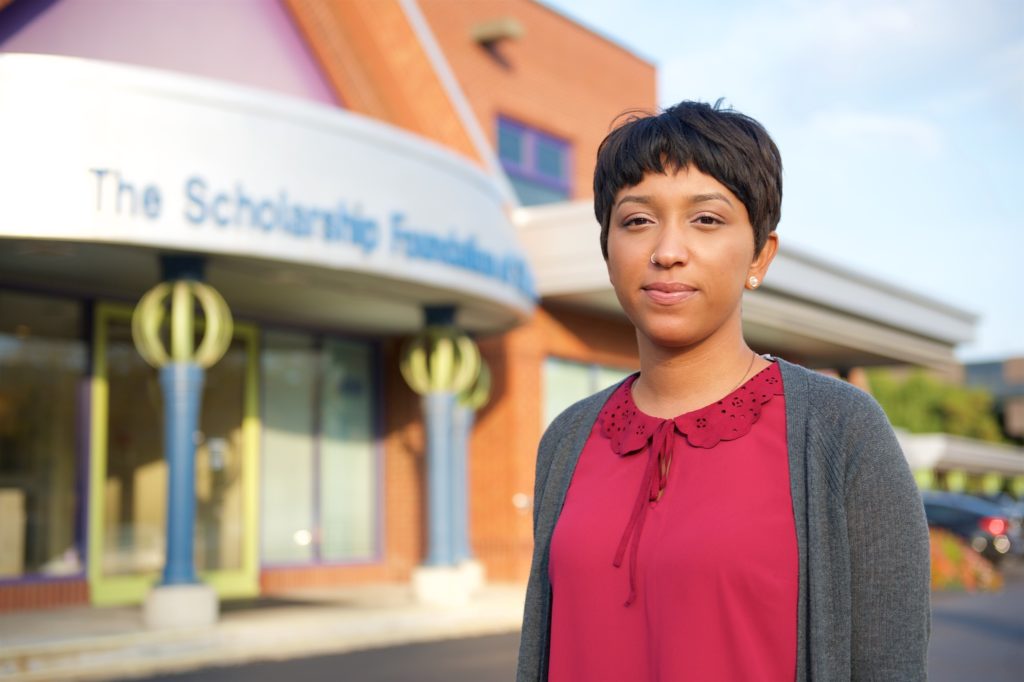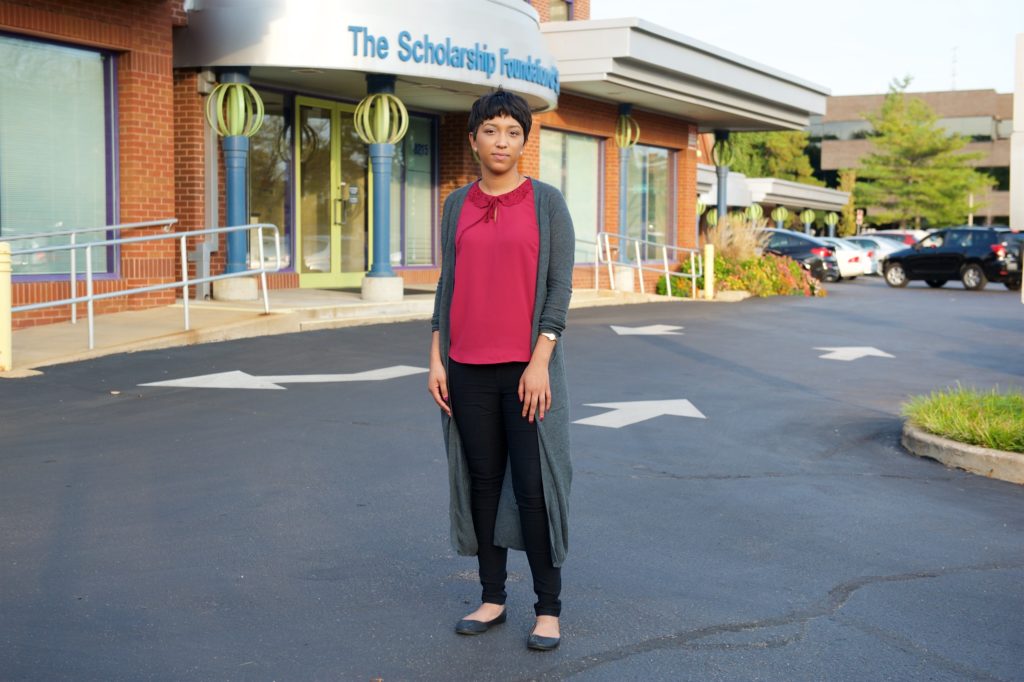When I went back to school for my Master’s degree, I began working part-time at The Scholarship Foundation of St. Louis as an education policy intern with five other students. During the second year of the internship program, we all had our umbrella issues we focused on as a group – mostly access for undocumented students and prioritizing need-based over merit-based aid – and we also got to work on our own projects. When I started my individual project, it was around the same time as Ferguson.
I really wanted to do something mostly focused on race. I was originally looking more at the institutional level in St. Louis and the question I hoped to answer was, “What does diversity mean to colleges in St. Louis?” We were actually on our way to Jefferson City to lobby for undocumented students’ access when we got a notification that there was going to be a hearing on the different state scholarship programs and ideas to restructure them. I knew about the basic structure of Bright Flight, Missouri’s merit-based scholarship awarded to top ACT test-takers across the state. I didn’t personally know anybody who had ever received it, but I had an idea which demographics of students were receiving this award.
They award Bright Flight to more than 6,000 students right now and there’s only one qualification — you have to score in the top 3% of ACT test takers in the state. That means students need a 31 out of a 36 on the ACT. In Missouri, the state average ACT score is a 21.5.
When I asked our executive director, “Has anybody ever looked into Bright Flight to see who is actually getting it?” she said, “Not that I know of.” I stayed up that whole night looking to see what I could find and there wasn’t much information out there at all. I just found general stuff on why merit-based aid is inequitable and why standardized test scores aren’t an accurate measure of intelligence or achievement. Well, Bright Flight is Missouri’s merit-based program that gives $3,000 of scholarship money to high school graduates for up to five years of college. They award Bright Flight to more than 6,000 students right now and there’s only one qualification — you have to score in the top 3% of ACT test-takers in the state. That means students need a 31 out of a 36 on the ACT. In Missouri, the state average ACT score is a 21.5.
Missouri’s need-based program is Access Missouri and it only gives $1,850 a year. Students have to fill out the FAFSA and demonstrate that they actually need that money, whereas with Bright Flight, they can have a full financial aid package from their school and still get that $3,000 on top. At many schools, if students have a certain GPA and ACT score, they may automatically get a full-ride scholarship. So Bright Flight can be used as an incentive to say, “Hey, if your student comes here, they’ll get an additional $3,000 on top of their full ride.”

Amber Overton, photos by Lindy Drew
I had an intuition that something was wrong with this program, but at that point, I did not have much data on the specifics of Bright Flight. I testified about it that following day in Jefferson City, but I didn’t have much to back up my claims and the legislative committee recognized that very quickly. The response was, “Yeah, that sounds good, but where’s your data? Where’s your evidence?” The legislators tore me apart.
So, my executive director said, “They want data? We’re going to give them data.” We formally requested it from the Missouri Department of Higher Education. The data was made up of Bright Flight recipients from the last four years broken down by high school. I combed through that data for a month trying to figure out who exactly is getting this award? Once I started seeing the numbers, I had to keep going. I literally triple-checked the numbers, like, “There’s no way what I’m seeing is actually true.” I went through it again and again and again.
The inequities within the program’s distribution were much worse than I thought. I originally thought the biggest discrepancy was going to be between private and public schools, but the biggest inequities actually came down to income. Private schools did have a disproportionately high number of recipients, but so did wealthier public schools. However, students from lower-income public schools and rural schools were extremely underrepresented as Bright Flight recipients.
If you’re familiar with the St. Louis high school landscape, the disparities in Bright Flight awards were even clear on a local level. The only SLPS schools that had Bright Flight recipients were Metro, Gateway, and McKinley – schools with lower percentages of low-income students and higher percentages of White students. It was telling just looking anecdotally in our area.
It was clear that this program overlooks students of color, lower-income students, and students in rural areas.
We couldn’t get race data with our study, but a peer-reviewed study published around the same time found that less than two percent of Bright Flight awards go to Black students, even though 13% of high school students in our state are Black. At this point, it was clear that this program overlooks students of color, lower-income students, and students in rural areas.
After we got the data, triple-checked it, and wrote the white paper, our education policy team started trying to figure out, “What are we going to do with this information?” We decided to make Bright Flight one of our priority issues for that year and organized a lobby day where we took 30 college students from all across the state to the capitol to talk with legislators. I got into the Education Policy Internship at The Scholarship Foundation of St. Louis not knowing much about policy or having a strong interest in it. But once I found my niche, I realized that policy is equally as important as direct practice. You can’t have one without the other.

If you’re going to a high school that doesn’t have the resources to prepare you for this test, it’s almost out of the realm of possibility to score a 31 or above. I’d never heard many students talking about Bright Flight, probably because the students I work with in under-resourced schools had never heard of it. As I explained it and its inequities to the students participating in the lobby day, they got it instantly. None of them had ever received it. They said, “I have a 4.0 and a 20 on my ACT. Does that mean I’m not bright?”
They said, “I have a 4.0 and a 20 on my ACT. Does that mean I’m not bright?”
The first time we went to lobby with students regarding Bright Flight, we personally delivered a packet to every legislator in the building. If they weren’t there, we gave it to their aide and followed up with calls. If they didn’t know about the inequities before, they definitely know now. The senator still pushing Bright Flight really heavily and trying to expand it won’t talk to us. We reached out to him a few times and no response. Even when we’ve tried to talk to him in person, his aide says he’s in a meeting. He’ll be in meetings all day. As we went to lobby as a coalition, I noticed the students taking charge. They were the ones talking to the politicians, not the policy interns, not the staff. The students were approaching legislators, telling them their personal stories and how they could have benefited from that extra $3,000 they not only deserved but needed. I was literally in tears that day.
In the Bright Flight white paper, we provided two sets of recommendations. In an ideal world, we proposed to just get rid of the program, put the money into Access Missouri, and give it to students who need it. But we knew that would be a hard sell because so many politicians support Bright Flight. So many of their children or relatives are getting Bright Flight funding, it’s really hard to tell somebody that money should be going to students who really need it. All they hear is you saying their kid doesn’t deserve it or their kid didn’t work for it.
Then we had our secondary recommendations. At the least, we have to restructure Bright Flight so a certain percentage of students in each district or building is getting this funding instead of the top 3% across all schools. Missouri has 800 high schools, but the 20 that are getting 1/3 of the program’s funding are Missouri’s wealthy, mostly suburban high schools with intense ACT preparation programs. How is a student from a Roosevelt or Normandy High supposed to compete with a student from Ladue or SLU High for an award that’s correlated to income? In addition, we have to restructure it so students have to fill out the FAFSA in order to get this money. You shouldn’t just throw money at students without knowing whether or not they need it, especially in a state that already invests a relatively low amount into higher education. We need to be careful and intentional about where we’re putting our scarce dollars.

Bright Flight was created 30 years ago as a response to the belief that many top achieving students were leaving the state to go to other states for college. The program was originally an incentive to keep students here. Even if students do stay in St. Louis for college, there’s no stipulation that says they have to stay in Missouri and work. They don’t have to do anything except go to college here. Theoretically, all 6,000 Bright Flight students could go to college here and then leave the state to work elsewhere. Bright Flight is not only problematic, but it’s also outdated. I don’t know if part of the original intent was racist or classist, but as it stands now, it definitely is and it just needs to go away.
ACT scores and standardized test scores are arbitrary when it comes to intelligence and achievement. So how are we still using this to measure our best and our brightest?
If we are going to have a merit program, there are much better ways to measure merit. ACT scores are convenient to use and easy to quantify, but we know ACT scores and standardized test scores are arbitrary when it comes to intelligence and achievement. So how are we still using this to measure our best and our brightest? There’s research that was done way before I started working on this project that says these scores are strongly tied to one thing, and that one thing is wealth.
Missouri’s lofty goal is to have 60% of our adult population attain some sort of college degree by 2025. Right now, we’re not even at 40%. How are we going to get there if we’re giving money to students who were probably going to college anyway and who don’t need the fund? It’s hard because, in a perfect world, all of the students would get money. We would be able to reward students for some type of merit. But if it comes down to merit versus need, need is morally and economically the better thing to do.

I’m in an interesting position as somebody who’s seen both sides, as somebody who, in certain ways, has been privileged and, in other ways, has not at all. That’s what really pushed me to learn more about this program. I’m from Nebraska, and we don’t have a merit-based state scholarship program. But when I learned of Bright Flight, I remembered my transition into college and finally understanding why my mom sent me to a private girls school for high school.
I come from a lower-income household, but, fortunately, my mom had enough money to partially pay my high school tuition and enough social capital to know where to look for high school scholarships for me. Had I gone to the public school that was not even 10 minutes from the school I went to, I don’t know where I would be now. My mother recognized my environment might limit my future opportunities and did what she could to change that. Now that I have a better understanding of my own privileges, I fight to make sure my students aren’t limited by circumstances out of their control.
I have more work to do. I don’t know if that is in policy or program development, but I know that college access and college access for Black students, in particular, is where I want to be. Working in this field in East St. Louis, I see the same type of ACT and GPA discrepancies that I saw when I was working with students in North County. I’ll have students with 4.5 GPAs and an 18 on the ACT. You’re not going to tell me this isn’t a bright student. You’re not going to tell me that student didn’t work hard for their 4.5 GPA. What you can tell me is that we’re using this test that is rooted in economic privilege to define achievement and intelligence.
Nearly every student I work with in East St. Louis comes from a low-income family. East St. Louis High is 99% low-income, and 99% Black. Just hearing the stories of some of my students, I commend them for even coming to school every day. Their level of resilience, that’s merit to me. The fact that they’re still here, that they graduated, that they’re still pushing through with all of these obstacles in their way – I think that’s merit, and much more than ACT performance and even grades.
In regards to Bright Flight, I am ready to see this program go away or be restructured. I’m not going to be satisfied until we change something.
-Amber Overton, College and Career Readiness Social Worker at East St. Louis High School, and Senior Education Policy Intern at Scholarship Foundation of St. Louis

